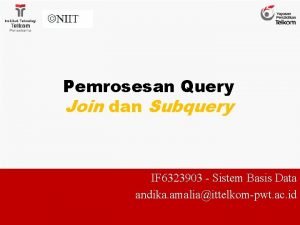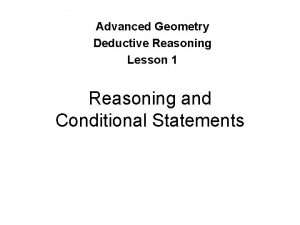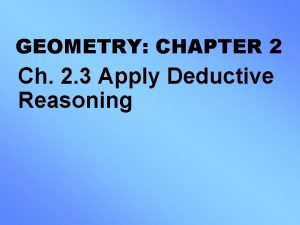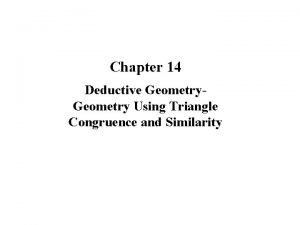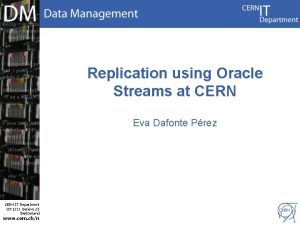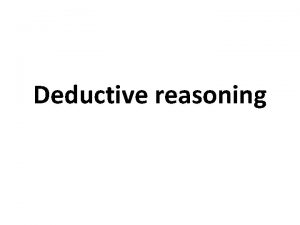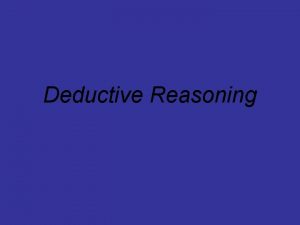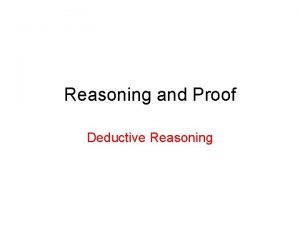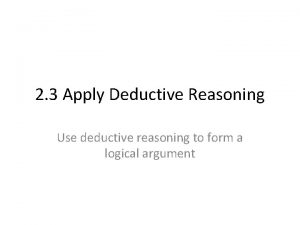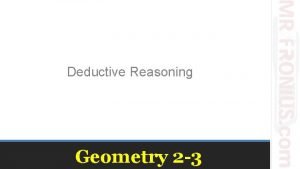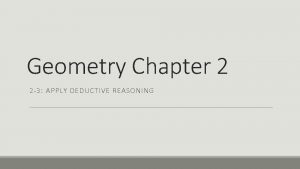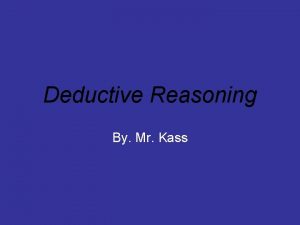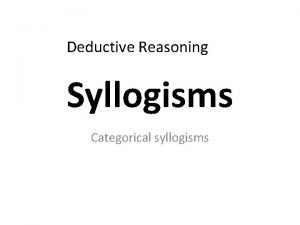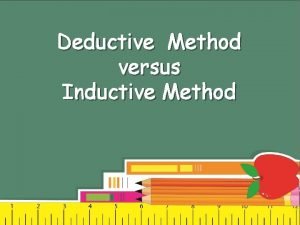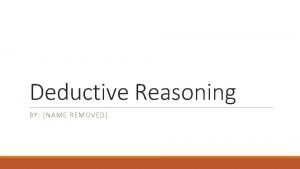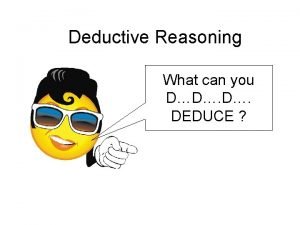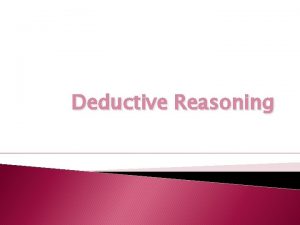GEOMETRY CHAPTER 2 Ch 2 3 Apply Deductive















- Slides: 15

GEOMETRY: CHAPTER 2 Ch. 2. 3 Apply Deductive Reasoning

Deductive reasoning uses facts, definitions, accepted properties, and the laws of logic to form a logical argument. This differs from inductive reasoning, which uses specific examples and patterns to form a conjecture.

KEY CONCEPT: LAWS OF LOGIC Law of Detachment—If the hypothesis of a true conditional statement is true, then the conclusion is also true.

Law of Syllogism: If hypothesis p, then conclusion q. If hypothesis q, then conclusion r. If hypothesis p, then conclusion r.

Ex. 1: Use the Law of Detachment to make a valid conclusion in the true situation. If two segments have the same length, then they are congruent. You know that BC=XY.

Ex. 1: Use the Law of Detachment to make a valid conclusion in the true situation. If two segments have the same length, then they are congruent. You know that BC=XY. Solution: Because BC=XY satisfies the hypothesis of a true conditional statement, the conclusion is also true. So,

Ex. 2. Use the Law of Detachment to make a valid conclusion in the true situation. Tim has a hockey game every Thursday evening. Today is Thursday. Step 1—Identify the hypothesis and the conclusion.

Ex. 2. (cont. ) The hypothesis is “If it is a Thursday evening” and the conclusion is “then Tim has a hockey game. ” “Today is Thursday” satisfies the hypothesis of the conditional statement. Therefore, you can conclude that Tim has a hockey game this evening.

Ex. 3: If possible, use the Law of Syllogism to write a new conditional statement that follows from the pair of true statements. a. If Jane takes chemistry this year, Ana will be Jane’s lab partner. If Ana is Jane’s lab partner, then Jane will get an A in chemistry. So, Jane will get an A in chemistry.

Ex. 3. b. If x 2 > 25, then x 2 > 20. If x > 5, then x 2 > 25. Solution: If x > 5, then x 2 > 20.

Ex. 3 c. If a polygon is regular, then all angles in the interior of the polygon are congruent. If a polygon is regular, then all of its sides are congruent. Solution: Neither statement’s conclusion is the same as the other statement’s hypothesis. You cannot use the Law of Syllogism in this case. For more examples, go to: http: //www. classzone. com/cz/books/geometry_2007_na/resources/applications/ animations/2_3. html

Ex. 4 a. If you get an B+ or better on your math test, then you can go to the movies. If you go to the movies, then you can watch your favorite actor. If you get an B+ or better on your math test, then you can watch your favorite actor.

Ex. 4: State the law of logic that is illustrated. b. The value of x is 21. Therefore, x - 4 > 13. Law of Detachment.

Ex. 5: Use Inductive and Deductive Reasoning What conclusion can you make about the product of an even integer with any other integer? Step 1: Look for a pattern in several examples. Use Inductive Reasoning. (-4)(2)=-8, (-2)(2)=-4, (1)(2)=2, (3)(2)=6 Conjecture: Even integer times any integer is equal to an even integer.

Ex. 5 (cont. ) Step 2—Let n and m be any integer. Use deductive reasoning to show the conjecture is true. 2 n is an even integer because any integer multiplied by two is even. 2 nm represents the product of an even integer and any integer m. 2 nm is the product of 2 and an integer nm. So, 2 nm is an even integer. The product of an even integer and any integer is an even integer.
 Cross apply vs outer apply
Cross apply vs outer apply Deductive reasoning geometry
Deductive reasoning geometry Inductive and deductive reasoning geometry examples
Inductive and deductive reasoning geometry examples Inductive reasoning vs deductive reasoning
Inductive reasoning vs deductive reasoning Deductive reasoning definition geometry
Deductive reasoning definition geometry Every quiz has been easy therefore the quiz will be easy
Every quiz has been easy therefore the quiz will be easy Geometry statements and reasons
Geometry statements and reasons Theory of structures
Theory of structures 4 electron domains 2 lone pairs
4 electron domains 2 lone pairs Electron geometry vs molecular geometry
Electron geometry vs molecular geometry Repl capture/apply: memory
Repl capture/apply: memory Monash overseas programs
Monash overseas programs Mcgill u apply
Mcgill u apply Hmda dpms
Hmda dpms Kent support and assistance number
Kent support and assistance number Infosys sabbatical leave
Infosys sabbatical leave
